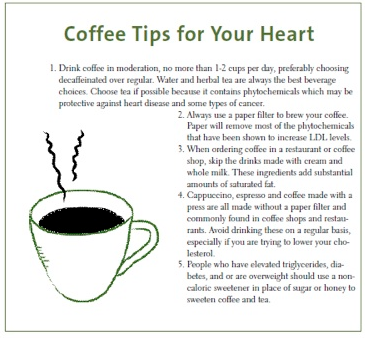
Coffee consumption has been linked to an increased risk of coronary heart disease and deaths from heart attacks in some studies,1 2 3 but not in many other studies.4 Studies that have found an association between coffee intake and heart disease have found it primarily in people who have consumed relatively large amounts (5-6 cups/day or more) of unfiltered coffee for many years. Many Americans consume more than 5 cups of coffee daily.
How Does Coffee Increase the Risk of Heart Attacks? How coffee consumption may increase the risk of heart attacks has been the subject of numerous studies. Removing caffeine from coffee does not necessarily remove the cholesterol-raising substance(s). A study that examined the impact of switching from regular coffee to decaffeinated found that when a group of 181 nonsmoking, healthy, coffee-drinking men switched to the decaf, their average LDL-cholesterol level increased significantly.5 This makes it clear that it is not the caffeine in the coffee that is responsible for the adverse effects on cholesterol levels. Phytochemicals to Blame About 70% of the coffee produced worldwide comes from the arabica bean. Researchers have now identified two phytochemicals in arabica coffee beans (kahweol & cafestol) that increase both LDL-cholesterol and triglyceride levels.6 These two substances are found in lesser amounts in other types of coffee beans. Fortunately, these two cholesterol-raising substances do not pass through a paper filter.7 This suggests that the potentially adverse effects of coffee drinking on blood lipids can be dramatically reduced by only consuming coffee that has passed through a paper filter. Wire mesh and nylon filters are less effective than paper. Homocysteine Higher More recently, coffee consumption has been linked to an increased level of homocysteine in the blood. Just as an increase in LDL-cholesterol increases cardiovascular disease, so too does an increase in homocysteine.8 Furthermore, a well-controlled study of 64 Dutch men showed that the consumption of 1 Liter (about 5-6 cups) of coffee daily for two weeks resulted in a 10% increase in plasma homocysteine levels.9 A 10% increase in plasma homocysteine level has been associated with about a 10-15% increased risk of coronary heart disease.10 So coffee that has not passed through a paper filter may increase the risk of heart attacks and strokes by raising both LDL-cholesterol and homocysteine levels in the blood. Perhaps even more disturbing for coffee-lovers are the results of a new study of 26 healthy men who consumed 1 liter of paper-filtered coffee for 4 weeks. In this study, fasting homocysteine levels were 18.5% higher after the subjects consumed paper-filtered coffee for 4 weeks than when they were not consuming any coffee for 4 weeks. If the results of this study are confirmed it seems likely that consuming 5-6 cups of coffee daily may significantly increase one’s risk of having a heart attack, even if the coffee they are drinking has passed through a paper filter. In addition to an increased risk of CVD, elevated homocysteine levels have been associated with an increased risk of pregnancy complications and adverse pregnancy outcomes.11
Bottom Line It is clear that more research is needed to determine how various forms and amounts of coffee may impact the risk of heart disease and perhaps other health problems. However, based on current research it seems prudent to advise those people with elevated LDL-cholesterol to avoid unfiltered coffee. It may also be prudent to advise people with elevated homocysteine levels to avoid all forms of coffee until the association between coffee intake and elevated plasma homocysteine levels has been worked out. By Dr. James J. Kenney, PhD, RD, FACN. More information on diet and heart disease can be found at www.foodandhealth.com References: 1. Tverdal A, Stensvold L, Solvoll K, et al. Br Med J 1990;300:566-9 2. Klatsky AL, Friedman GD, Armstrong MA. Am J Epidemiol. 1990;132:478-88 3. La Croix AZ, Mead LA, Liang KY, et al. N Engl J Med 1986;315:977-82 4. Myers MG, Basinski A. J Intern Med 1992;152:1767-72 5. Superko HR, Bortz W, Williams PT, et al. Am J Clin Nutr 1991;54:599-605 6. van Rooij J, van der Stegen GHD, Schoemaker RK, et al. Am J Clin Nutr 1995;61:1277-83 7. van Dusseldorp M, Katan MB, van Vliet T, et al. Atheroscler Thromb 1991;11:586-93 8. Eikelboom JW, Lonn E, Jenest J, et al Ann Intern Med 1999;131:363-75 9. Grubben MJ, Boers GH, Blom HJ, et al. Am J Clin Nutr. 2000;71:480-4 10. Anderson JL, Muhlestein JB, Horne BD, et al. Circulation 2000;102:1227-32 11. Eskes TK. Open or closed? Nutr Rev 1998;56:236-44.
 Coffee consumption has been linked to an increased risk of coronary heart disease and deaths from heart attacks in some studies,1 2 3 but not in many other studies.4 Studies that have found an association between coffee intake and heart disease have found it primarily in people who have consumed relatively large amounts (5-6 cups/day or more) of unfiltered coffee for many years. Many Americans consume more than 5 cups of coffee daily.
Coffee consumption has been linked to an increased risk of coronary heart disease and deaths from heart attacks in some studies,1 2 3 but not in many other studies.4 Studies that have found an association between coffee intake and heart disease have found it primarily in people who have consumed relatively large amounts (5-6 cups/day or more) of unfiltered coffee for many years. Many Americans consume more than 5 cups of coffee daily.

